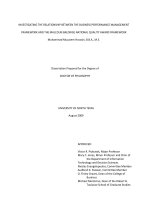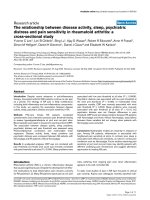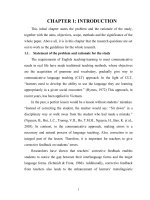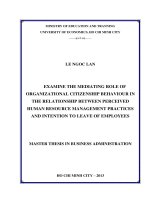Investigating the relationship between the business performance management framework and the Malcolm Baldrige National Quality Award framework
Bạn đang xem bản rút gọn của tài liệu. Xem và tải ngay bản đầy đủ của tài liệu tại đây (2.58 MB, 159 trang )
APPROVED:
Victor R. Prybutok, Major Professor
Mary C. Jones, Minor Professor and Chair of
the Department of Information
Technology and Decision Sciences
Nicolas Evangelopoulos, Committee Member
Audhesh K. Paswan, Committee Member
O. Finley Graves, Dean of the College of
Business
Michael Monticino, Dean of the Robert B.
Toulouse School of Graduate Studies
INVESTIGATING THE RELATIONSHIP BETWEEN THE BUSINESS PERFORMANCE MANAGEMENT
FRAMEWORK AND THE MALCOLM BALDRIGE NATIONAL QUALITY AWARD FRAMEWORK
Muhammad Muazzem Hossain, B.B.A., M.S.
Dissertation Prepared for the Degree of
DOCTOR OF PHILOSOPHY
UNIVERSITY OF NORTH TEXAS
August 2009
UMI Number:
3385793
All rights reserved
INFORMATION TO ALL USERS
The quality of this reproduction is dependent upon the quality of the copy submitted.
In the unlikely event that the author did not send a complete manuscript
and there are missing pages, these will be noted. Also, if material had to be removed,
a note will indicate the deletion.
UMI
3385793
Copyright 2009 by ProQuest LLC.
All rights reserved. This edition of the work is protected against
unauthorized copying under Title 17, United States Code.
ProQuest LLC
789 East Eisenhower Parkway
P.O. Box 1346
Ann Arbor, MI 48106-1346
Hossain, Muhammad Muazzem. Investigating the relationship between the business
performance management framework and the Malcolm Baldrige National Quality Award
framework
The business performance management (BPM) framework helps an organization
continuously adjust and successfully execute its strategies. BPM helps increase flexibility by
providing managers with an early alert about changes and, as a result, allows faster response to
such changes. The Malcolm Baldrige National Quality Award (MBNQA) framework provides a
basis for self-assessment and a systems perspective for managing an organization’s key
processes for achieving business results. The MBNQA framework is a more comprehensive
framework and encapsulates the underlying constructs in the BPM framework.
. Doctor of Philosophy (Management Science), August 2009, 149 pp., 24 tables, 15
figures, references, 60 titles.
The objectives of this dissertation are fourfold: (1) to validate the underlying
relationships presented in the 2008 MBNQA framework, (2) to explore the MBNQA framework
at the dimension level, and develop and test constructs measured at that level in a causal
model, (3) to validate and create a common general framework for the business performance
model by integrating the practitioner literature with basic theory including existing MBNQA
theory, and (4) to integrate the BPM framework and the MBNQA framework into a new
framework (BPM-MBNQA framework) that can guide organizations in their journey toward
achieving and sustaining competitive and strategic advantages.
The purpose of this study is to achieve these objectives by means of a combination of
methodologies including literature reviews, expert opinions, interviews, presentation
feedbacks, content analysis, and latent semantic analysis. An initial BPM framework was
developed based on the reviews of literature and expert opinions. There is a paucity of
academic research on business performance management. Therefore, this study reviewed the
practitioner literature on BPM and from the numerous organization-specific BPM models
developed a generic, conceptual BPM framework. With the intent of obtaining valuable
feedback, this initial BPM framework was presented to Baldrige Award recipients (BARs) and
selected academicians from across the United States who participated in the Fall Summit 2007
held at Caterpillar Financial Headquarter in Nashville, TN on October 1 and 2, 2007.
Incorporating the feedback from that group allowed refining and improving the proposed BPM
framework.
This study developed a variant of the traditional latent semantic analysis (LSA) called
causal latent semantic analysis (cLSA) that enables us to test causal models using textual data.
This method was used to validate the 2008 MBNQA framework based on article abstracts on
the Baldrige Award and program published in both practitioner and academic journals from
1987 to 2009. The cLSA was also used to validate the BPM framework using the full body text
data from all articles published in the practitioner journal entitled the Business Performance
Management Magazine since its inception in 2003. The results provide the first cLSA study of
these frameworks. This is also the first study to examine all the causal relationships within the
MBNQA and BPM frameworks.
ii
Copyright 2009
by
Muhammad Muazzem Hossain
ACKNOWLEDGMENTS
IwouldliketoexpressmygratitudetomydissertationchairDr.VictorPrybutokforhis
advice,compassion,guidance,patience,andsupervisionfromtheverybeginningofthis
dissertation.Dr.Prybutokprovidedmeunflinchingencouragement,mentoring,andsupportin
variousways.Iamindebtedtohimmorethanheknows.
IgratefullyacknowledgeDr.MaryJones,Dr.NicolasEvangelopoulos,andDr.Audhesh
Paswanfortheirinsightfulguidance,unconditionalsupportandunlimitedencouragement.
ManythankstomyfellowfriendsinthePh.D.programwhowerethereforme
wheneverIneededthem.Thankstoallmyfriendswhohelpedmeinmanywaysincompleting
myPh.D.program.
Lastly,tomyparents,brothers,sisters,andmywifeMahfujaIslam,wordscannot
expressmygratitudefortheirunconditionalloveandsupport.Withouttheir“you‐can‐do‐it”
encouragement,itwouldnothavebeenpossibleformetoaccomplishwhatIhavetoday.
iii
TABLEOFCONTENTS
Page
ACKNOWLEDGMENTS iii
LISTOFTABLES v
LISTOFFIGURES vii
Chapters
1.INTRODUCTION 1
2.LITERATUREREVIEW 8
TheMBNQAFramework 8
TheBPMFramework 19
LatentSemanticAnalysis(LSA) 27
TheBPM‐MBNQAConceptualFramework 31
ResearchModelsandPropositions 35
3.RESEARCHMETHODOLOGY 83
Corpus1:MBNQAInput‐Output(XY)Statements 84
Corpus2:IJBPMAbstracts 87
Corpus3:BPMInput‐Output(XY)Statements 87
4.ANALYSESandRESULTS 89
cLSAofCorpus1 89
LSAofCorpus2 100
cLSAofCorpus3 106
5.DISCUSSION,IMPLICATIONS,and FUTUREDIRECTION 119
Discussion 119
Implications 123
FutureDirection 124
APPENDICES 126
REFERENCES 145
iv
LISTOFTABLES
Page
Table1:BriefdescriptionofMBNQAcategories 12
Table2:BriefdescriptionofMBNQAdimensionlevelconstructs 13
Table3:MajorBPMconsultingfirmsandtheiractivities 22
Table4:BriefdescriptionoftheBPMframeworkconstructs 26
Table5:CorrespondenceoftheBPMconstructstotheMBNQAconstructs 34
Table6:Tabularviewofresults‐relatedpropositionsforMBNQAcategorylevelframework 52
Table7:Tabularviewofsystem’spropositionsforMBNQAcategorylevelframework 62
Table8:TabularviewoftheMBNQAdimensionlevelpropositions 76
Table9:ListofjournalswithMBNQA‐relatedabstracts 86
Table10:SummaryoftwofactorsofthecausalMBNQAframework 91
Table11:Inter‐factorfrequency measures 92
Table12:Inter‐factorpercentagemeasures 92
Table13:SummaryofsevenfactorsofthecausalMBNQAframework 94
Table14:Inter‐factorfrequency measuresforseven‐factorMBNQAframework 97
Table15:Inter‐factorpercentagemeasuresforseven‐factorMBNQAframework 98
Table16:SummaryoftwosemanticfactorsofBPMframework 101
Table17:SummaryoftensemanticfactorsofBPMframework 103
Table18:SummaryoftwofactorsofthecausalBPMframework 108
Table19:Inter‐factorfrequency measures 109
Table20:Inter‐factorpercentagemeasures 109
v
Table21:SummaryoftenfactorsofthecausalBPMframework 111
Table22:Inter‐factorfrequency measures 114
Table23:Inter‐factorpercentagemeasures 115
Table24:Significantpercentagesupports 117
vi
vii
LISTOFFIGURES
Page
Figure1:The2008MBNQAperformanceexcellenceframework 15
Figure2:MBNQAcorevaluesandconcepts,criteria,andoutcomes(NIST,2008,p.49) 17
Figure3:TheproposedBPMframework 25
Figure4:Schematicofterm‐by‐documentmatrixX 28
Figure5:TheBPM‐MBNQAconceptualframework 33
Figure6:The2008MBNQAframeworkatthecategorylevel 36
Figure7:The2008MBNQAframeworkatthedimensionlevel 62
Figure8:TheproposedBPMframework(repeated) 77
Figure9:Causalsemanticnetfortwo‐factorMBNQAframework 92
Figure10:Causalsemanticnetforseven‐factorMBNQAframework 99
Figure11:Causalsemanticnetfortwo‐factorBPMframework 109
Figure12:Causalsemanticnetforten‐factorBPMframework 118
Figure13:EmpiricalevidenceoftheMBNQAframework 120
Figure14:TheoperationalpathsofBPM 122
Figure15:ThestrategicpathsofBPM 123
CHAPTER1
INTRODUCTION
TheMalcolmBaldrigeNationalQualityAward(MBNQA)frameworkprovidesabasisfor
self‐assessmentandasystemsperspectiveformanaginganorganization’skeyprocessesfor
achievingbusinessresults.Thebusinessperformancemanagement(BPM)frameworkhelpsan
organizationcontinuouslyadjustandsuccessfullyexecuteitsstrategies.BPMhelpsincrease
flexibilitybyprovidingmanagerswithasenseofuncertainchangesearlierandallowsfaster
responsetosuchchanges.Itthushelpsorganizationsaddressmarketopportunities.The
simultaneoususeoftheMalcolmBaldrigeNationalQualityAward(MBNQA)frameworkandthe
businessperformancemanagement(BPM)frameworkbyanorganizationhasthepotentialto
helporganizationspursueexcellencewhilesimultaneouslyincreasingtheiragilityand
competitiveadvantage.Therefore,tofacilitatetheabilitytousebothframeworks
simultaneouslyfororganizationaladvantageIexaminetheexistingliteratureandfromitglean
thecommonrelationshipsamongtheframeworksandusethesefindingstopositanintegrated
framework.
TheMalcolmBaldrigeNationalQualityAwardcriteriaprovideacomprehensive
frameworkforself‐assessmentandembodyasystematicapproachtoorganizationalquality
(Bemowski&Stratton,1995;Evans1997;Pannirselvam&Ferguson,2001).Thecriteriaare
groupedintosevencategoriesthatshowtheunderlyingrelationshipsamongandbetween
organizationalperformanceandvariousqualitymanagementconstructs(Pannirselvam&
Ferguson,2001).TheserelationshipsareportrayedintheMalcolmBaldrigeNationalQuality
Award(MBNQA)framework.TheMBNQAcriteriadefinepracticesinsevencategories‐(1)
1
leadership,(2)strategicplanning,(3)customerandmarketfocus,(4)measurement,analysis,
andknowledgemanagement,(5)workforcefocus,(6)processmanagement,and(7)results.
Thesesevencategoriesarecomposedofasetof18performance‐orientedcriteriaitems.Each
ofthesecategoriesembodiestwoormorecriteriaitems.Forinstance,theleadershipcategory
iscomposedoftwocriteriaitems:seniorleadership,andgovernanceandsocialresponsibilities.
TheBaldrigecriteriaalsoshedlightonaskingquestionsthatorganizationscanusetoestablish
vitallinkagesintheirstructure,operations,strategy,andresults.Forexample,akeyquestion
itemregardingthecustomerandmarketknowledgecriteriaitemishoworganizationsidentify
customers,customergroups,andmarketsegments.Thesequestionitemsprovidepractitioners
andacademicianswithinvaluableinsightsfordevelopingselftestinginstruments.However,
becauseoftheuseofthesameterm“items”toindicatecriteriaitemsandquestionitemsthere
isthepotentialfortheconfusioninacademicliteratureofthesequestionitemswiththecriteria
items.Therefore,Iintendtomakeadistinctionattheonsetbetweenthecriteriaitemsandthe
questionitemsbylabelingthecriteriaitemsasthedimensionsofthecategories.Thus,the
Baldrigeframeworkisaframeworkofseveninterrelatedconstructs(categories)witheach
constructhavingtwoormoredimensionswitheachdimensionmeasuredwithmultiple
questionitems.
TheMBNQAframeworkwasfirstcreatedin1987forthepurposeofimproving
organizationalcompetitiveness(Garvin,1991;Gradig&Harris,1994)andhasevolved
continuouslysinceitsinception(NationalInstituteofStandardsandTechnology[NIST],1993;
Bemowski,1996;NIST,1997;NIST,2000;NIST,2007;NIST,2008).The2007criteriabring
significantchangesfromthe2006criteriainalmostallcategoriesanddimensions,andthese
2
changesincludeaddingseventermstotheGlossaryofKeyTerms(NIST,2007,p.8‐9).These
changesarereflectedintheframeworkintermsofnewandmodifiedunderlyingrelationships.
Forexample,the2007criteriaassumethatstrategicplanninghasastrongerfocusthanin
previousframeworksoninnovation,strategicadvantages,andresourceneedstoachieve
strategicobjectives.However,NIST(2008)posits:
In 2007, the Baldrige Criteria were significantly revised to encourage
organizations to consider carefully their strategic advantages, core
competencies, and opportunities for innovation and how these considerations
drive key decisions on work systems (such as outsourcing, partnerships, and
workforce decisions). In recognition of the challenges for organizations to
address these opportunities, the decision was made to make no substantive
revisionstotheCriteriafor2008.(NIST,2008,p.27)
Themostsignificantchangesinthe2008bookletincludetheadditionoftheterm
“StrategicAdvantages”totheGlossaryofKeyTerms,andtwonewdiagrams–oneofwhich
illustratestheroleofcorevaluesandconceptsinunderpinningthecriteria,andtheother
showsmaturitylevelsinorganizationallearning(NIST,2008).Therefore,the2007framework
andthe2008frameworkcanbeusedinterchangeably.Therelationshipsintheproposed
conceptuallyenhanced2007/2008frameworkarecurrentlynotvalidatedintheacademic
literature.Validatingthe2007/2008frameworkwillsupporttheframework’scurrentformas
wellasprovidemanagerswithmeaningfulinformationthattheycanuseindecidingwherethey
shouldfocustheireffortsinachievingperformanceexcellence.Therefore,thefirstobjectiveof
thisstudyistovalidatetheunderlyingrelationshipspresentedinthe2007/2008framework.
TheMBNQAframeworkenjoyswidespreadacceptanceatlocal,national,and
internationallevels(Kochan,1992;Ettorre,1996;Pannirselvam,Siferd,&Ruch,1998).Various
studieshaveused,extendedandtestedthisframeworkinseveralindustries,suchashealth
3
care(Prybutok&Spink,1999;Meyer&Collier,2001),governmentorganizations(Pannirselvam
etal.,1998;Pannirselvam&Ferguson,2001),andhighereducation(Winn&Cameron,1998).
However,thesestudiestestedtheframeworkatthecategorylevel.Thereisapaucityof
evidencetestingtheMBNQAframeworkatthedimensionlevel.Adimensionlevelanalysiswill
provideacademiciansandmanagerswithbetterinsightregardinghoweachiteminacategory
isrelatedtospecificitemsinothercategories(Pannirselvam&Ferguson,2001).Thatis,
dimensionlevelanalysisisnecessarytobetterunderstandhowvariousqualitymanagement
aspectsaffecteachotherandimpactbusinessperformance(Evans,1997).Therefore,the
secondobjectiveofthisstudyistoexploretheMBNQAframeworkatthedimensionlevel,and
developandtestconstructsmeasuredatthatlevelinacausalmodel.
TheBPMframeworkembodiesaclosed‐loop.Cokins(2007)positsthatbusiness
performancemanagementexisteddecadesagoandthatorganizationsweredoingperformance
managementlongbeforeitwaslabeledsuchin1990sbyinformationtechnologyresearchfirms
andsoftwarevendors.Thereislittleornoresearchinacademiaonbusinessperformance
management.SeveralpractitionerBPMframeworksexistbuttheseareindustryspecificand
varyfromindustrytoindustry(Eckerson,2004;Cokins,2007).However,allsuchframeworks
havecommonconstructs–developstrategy;define,measureandmanageperformanceagainst
strategicgoal;continuouslyadjustandrefinestrategy;andoptimizethestrategicexecution.
Therefore,thethirdobjectiveofthisworkistovalidateandcreateacommongeneral
frameworkforthebusinessperformancemanagementbyintegratingthepractitionerliterature
withbasictheoryincludingexistingMBNQAtheory.
4
The2008criteriaplacesignificantimportanceoncompetitiveadvantages,strategic
advantages,corecompetencies,andinnovation.TheBaldrigecriteriaaskthought‐provoking,
criticalquestionsthatemphasizeanorganizationalinfrastructurethatisessentialtomaintain
andimprovecompetitiveadvantageandbringaboutinnovation.Oneimpedimenttoachieving
improvedorganizationeffectivenessandcompetitivenessisthehugegapbetweenstrategyand
execution(Eckerson,2004).Eckerson(2004)suggeststhatbusinessperformancemanagement
(BPM)bridgesthegapbetweenstrategyandexecution.EckersonalsopositsthatBPMhelps
organizationsexploitmarketopportunitiesastheyarise,andmakeorganizationsmore
effective,andmorecompetitive.Therefore,thefinalobjectiveofthisstudyistointegratethe
businessperformancemanagementframeworkandtheMBNQAframeworkintoanew
framework(BPM‐MBNQAframework)thatcanguideorganizationsintheirjourneytoward
achievingandsustainingcompetitiveandstrategicadvantages.
Insummary,theobjectivesareasfollows:
1. Validatetheunderlyingrelationshipspresentedinthe2008MBNQAframeworkat
thecategorylevel
2. ExploretheMBNQAframeworkatthedimensionlevel,anddevelopandtest
constructsmeasuredatthatlevelinacausalmodel
3. Validateandcreateacommongeneralframeworkforthebusinessperformance
managementbyintegratingthepractitionerliteraturewithbasictheoryincluding
existingMBNQAtheory
4. IntegratetheBPMframeworkandtheMBNQAframeworkintoanewframework
(BPM‐MBNQAFramework)thatcanguideorganizationsintheirjourneytoward
achievingandsustainingcompetitiveandstrategicadvantages
Thepurposeofthisstudyistoachievetheseobjectivesbymeansofacombinationof
methodologiesincludingliteraturereviews,expertopinions,interviews,presentation
5
feedbacks,contentanalysis,andlatentsemanticanalysis.AninitialBPMframeworkwas
developedbasedonthereviewsofliteratureandexpertopinions.Thereisapaucityof
evidenceofacademicresearchinbusinessperformancemanagement.Therefore,thisstudy
reviewedthepractitionerliteratureonBPManddevelopedageneric,conceptualBPM
framework.Withtheintentofobtainingvaluablefeedback,thisinitialBPMframeworkwas
presentedtoBaldrigeAwardrecipients(BARs)andselectedacademiciansfromacrossthe
UnitedStateswhoparticipatedintheFallSummit2007heldatCaterpillarFinancial
HeadquarterinNashville,TNonOctober1and2,2007.Inc orporatingthefeedback,arefined,
improvedBPMframeworkhasbeenproposed.
Inlinewiththeabove‐mentionedresearchobjectives,thestudyseekstoaddressthe
followingresearchquestions:
1. AretheproposedrelationshipsbetweenthecategoriesintheMBNQA2008
frameworksupported?
2. Howarethedimensionsrelatedwithineachcategoryandbetweencategoriesinthe
MBNQA2008framework?
3. IstheproposedBPMframeworksupportedbytheextantliterature?
4. DoesBPMframeworkcontributetoenhancedcompetitivenessandinnovation?
5. HowistheproposedBPMframeworkrelatedtothe2008MBNQAframework?
Thisstudyusescausallatentsemanticanalysis(cLSA)tovalidatetheproposedBPM
frameworkandthe2008MBNQAframework.ThecausalLSA(cLSA)isamodificationandthusa
derivativeofthetraditionallatentsemanticanalysis.Inadditiontouncoveringthelatent
factors,thecLSAestablishescausalrelationshipsamongthesefactorsbasedontheinputand
outputstatementscontainedinthefactors(seeAppendixBfordetail).TovalidatetheBPM
6
framework,IperformedcLSAonaBPMcorpusdevelopedbasedonthefullbodytextdatafrom
allarticlespublishedinthepractitionerBPMjournalentitledtheBusinessPerformance
ManagementMagazinesinceitsinceptionin2003.Inaddition,thetraditionallatentsemantic
analysis(LSA)wasusedtouncoverthelatentsemanticsoftheBPMframeworkfromthearticle
abstractspublishedintheInternationalJournalofBusinessPerformanceManagement.To
validatetheMBNQAframework,IperformedcLSAonanMBNQAcorpusobtainedfromthe
articleabstractsontheBaldrigeAwardandprogrampublishedinpractitionerandacademic
journalsfrom1987to2009.
Theremainingofthestudyisorganizedasfollows.Chapter2providesareviewofthe
literatureontheMBNQA,BPMandlatentsemanticanalysis.Chapter2alsodelineatesthe
researchmodelsandgeneratespropositionsfortestingtheresearchobjectives.Chapter3
articulatestheresearchmethods,constructmeasurement,sampledesign,scaledevelopment,
anddatacollectionsoastoanswertheresearchquestionspresentedinChapter1.Chapter4
providesthedataanalysisandresults.Finally,Chapter5discussesthelimitations,contributions
andimplicationsofthestudy.
7
CHAPTER2
LITERATUREREVIEW
ThischapterprovidesareviewoftheliteratureontheMalcolmBaldrigeNational
QualityAward(MBNQA)framework,thebusinessperformancemanagement(BPM)framework
andlatentsemanticanalysis(LSA).Therearefivesectionsinthischapter.Thefirstsection
presentsareviewoftheliteratureontheMBNQAframework.Thesecondsectionprovidesa
reviewofthepractitionerliteratureonBPM.AconceptualBPMframeworkisproposedbased
onthereviewofthepractitionerliterature.Thethirdsectiondiscusseslatentsemanticanalysis.
SectionfourdiscusseshowtheBPMandtheMBNQAframeworkcanbeintegrated;andit
presentstheintegratedBPM‐MBNQAconceptualframework.Finally,researchpropositionsare
detailedinsectionfive.
TheMBNQAFramework
TheMalcolmBaldrigeNationalQualityAward(MBNQA)isconsideredthehighesthonor
forbusinessexcellenceinAmerica(TYBEA,2001).TheUnitedStatesDepartmentofCommerce
establishedtheBaldrigeAwardandtheBaldrigeNationalQualityProgramin1987tojumpstart
asmall,slowlygrowingqualitymovement(TYBEA,2001).TheBaldrigeAwardandprogram
playsacriticalroleinstrengtheningcompetitiveness(Bell&Keys,1998)withtheintentof
achievingthreespecificgoals–topromotequalityawareness,torecognizequalityachievement
ofU.S.companies,andtopublicizesuccessfulstrategies(Bemowski&Stratton,1995;TYBEA,
2001;NIST,2007).TheNationalInstituteofStandardsandTechnology (NIST)oftheUS
CommerceDepartmentdesignsandmanagestheBaldrigeAwardandprogram.Congress
selectedNISTtoadministertheBaldrigeAwardbecauseof“itslong‐standingroleinhelping
8
U.S.companiescompete,itsworld‐renownedexpertiseinqualitycontrolandassurance,andits
reputationasanimpartialthirdparty”(TYBEA,2001,p.5).
ThefirstBaldrigeAwardswerepresentedin1988tothreecompanies.TheUnitedStates
presidentpresentstheawardstotherecipients.From1988to1998,theawardsweregivento
eachofthreesectors–manufacturing,service,andsmallbusiness.WiththeOctober1998
passageoflegislation,NISTestablishedBaldrigeAwardsforeducationorganizationsand
healthcareproviders;andthefirstapplicationsforawardswereacceptedin1999(TYBEA,
2001).NISTwasauthorizedtoexpandtheBaldrigeAwardprogramtonon‐profitorganizations
bytheOctober2004legislationsignedintolawbyPresidentBush.Thefirstapplicationsfor
awardsinthenon‐profitorganizationssectorwereacceptedin2007(NIST,2007).
NowNISTdesignsandmanagestheBaldrigeAwardandprogramformanufacturing,
service,smallbusiness,education,healthcare,andnon‐profitorganizations.Threeframeworks
areprovidedbyNISTtoadministerawardsinthesecategories.Thefirstframeworkembodies
criteriaforbusinessandnon‐profitorganizationsandisusedformanufacturing,smallbusiness,
serviceandnon‐profitcategories.Thesecondandthirdframeworksprovidecriteriafor
educationorganizationsandhealthcareproviders,respectively.NISTprovidesthree
frameworkstocapturethepeculiaritythatexistsacrossindustries.However,thebottom‐line
purposesandunderpinningsofallframeworksarethesame.Minordifferencesinframeworks
existinthenameofthedimensionsoftheframeworksandareneededtoreflecttheesoteric
characteristicsofeachindustry.Forinstance,thetermcustomerisbettersuitedtobusinesses
andnon‐profitorganizations.Thetermpatientismoreappropriateinthehealthcareindustry.
Thedifferencesinframeworksarereflectedasfollows:(1)thecategoryCustomerandMarket
9
Focusinthebusinessandnon‐profitcriteriaisreplacedwithFocusonPatients,Other
Customers,andMarketinhealthcarecriteria,andwithStudent,Stakeholder,andMarketFocus
ineducationcriteria,and(2)thedimensionsintheResultscategoryhavebeennamedinthe
frameworkstoreflectthedistinctiveoutcomesofeachindustry.
Theunderlyingcausalrelationshipsandthedesignstructureoftheframeworksremain
unchangedacrossindustries.Therefore,theterms“MalcolmBaldrigeNationalQualityAward
framework,”“MBNQAperformanceexcellenceframework,”“MBNQAmodel,”“Baldrige
framework,”and“Baldrigemodel”areusedtoembodythecausalrelationshipsandthe
skeletonofallframeworks.Becausetherelationshipsandtheskeletonoftheframeworksare
thesame,thebusinessandnon‐profitframeworkisusedhereonasarepresentationofthe
Baldrigemodel,theMBNQAmodelortheMBNQAframework.Inlinewithoneoftheobjectives
ofthisresearch,the2008BaldrigecriteriaarereferredtothetheoreticalMBNQAframework.
Thebottom‐linephilosophyofthe Baldrigeframeworkistoprovideasystems
perspectiveformanagingorganizationsandtheirkeyactivitiesandprocessestoobtainresults.
TheMBNQAframeworkdefinessevencriteriacategoriesthataredesignedtoendow
organizationswithanintegratedapproachtoperformanceexcellence.Thesecriteriacategories
are(1)leadership,(2)strategicplanning,(3)customerandmarketfocus,(4)measurement,
analysis,andknowledgemanagement,(5)workforcefocus,(6)processmanagement,and(7)
results.TheBaldrigescoringsystemencompassesthesesevencriteriacategoriesanddivides
themintotwoevaluationdimensions:(1)processand(2)results.“Process”referstothe
methodsthatorganizationsusetoaddresstherequirementsinCategories1–6,while“Results”
referstoorganizations’outputsandoutcomesinachievingtherequirementsinCategory7
10
(NIST,2008).ThetwoevaluationdimensionsarecentraltotheBaldrigeAwardapplicant
evaluationandfeedback.Acriticalfactorinevaluationandfeedbackistheimportanceofan
organization’sreportedprocessandresultstoitskeybusinessfactors.NISTsuggeststhat
organizationsidentifytheareasoftheirgreatestimportanceandreportthemintheir
organizationalprofile.NISTpositsthatorganizationalprofileisthemostimportantstarting
pointforself‐assessmentandforwritinganapplication.Inaddition,organizationalprofilehelps
organizationsidentifypotentialgapsinkeyinformationandfocusonkeyperformance
requirementsandresults.Itsetsthecontextsuchasoperatingenvironment,keyworking
relationships,andstrategicchallengesandadvantagesforthewayanorganizationoperates.
Therefore,organizationalprofileservesasanoverarchingguideforanorganization’s
performancemanagementsystem.However,organizationalprofileisnotconsideredacriteria
categoryanddoesnotcontributetowardthescoringsystem.Thisstudyinvestigatesthe
underlyingrelationshipsamongthesevencriteriacategoriesandthusconsidersthediscussion
oforganizationalprofileforfurtherresearch.Abriefdescriptionofthecriteriacategoriesis
giveninTable1.Table2providesabriefdescriptionoftheMBNQAconstructsatthedimension
level.
11
Table1:BriefdescriptionofMBNQAcategories
Constructs Description
1.Leadership Examineshoworganization’sseniorleadersguideandsustaintheir
organization,howorganizationsviewtheirgovernancesystem,andhow
organizationsfulfilltheirethical,legal,andcommunityresponsibilities
(NIST,2008).
2.Strategic
planning
Examineshoworganizationsdeterminetheirshortandlongtermgoals,
andhoworganizationsmakeplanstoenhancerelationshipswith
customers,suppliers,andpartners(NIST,2008;Prybutok,Zhang,&Ryan,
2008).
3.Customerand
marketfocus
Describeshoworganizationsdetermineproductandserviceexpectations,
identifycustomergroupsandmarketsegments,andmeasurecustomer
satisfactionlevelstoensurethecontinuingrelevanceofproductand
serviceandtodevelopnewbusinessopportunities(NIST,2008;Prybutok
etal.,2008).
4.Knowledge
management
Examinesorganization’sselection,gathering,analysis,management,and
improvementofdata,information,knowledge,andinformation
technology.Alsoexamineshoworganizationsusereviewtoimprovetheir
performance(NIST,2008).
5.Workforce
focus
Examinesorganization’sabilitytoengage,manage,develop,andassessits
workforceinalignmentwithitsoverallmission,strategy,andactionplans
(NIST,2008).
6.Process
management
Examineshoworganizationsdeterminetheircorecompetenciesandwork
systems,andhowtheydesign,manageandimprovetheirkeyprocessesto
implementthoseworksystems(NIST,2008).
7.Results Examinesorganization’sperformanceandimprovementinallkeyareas
includingproductandserviceoutcomes,customer‐focusedoutcomes,
financialandmarketoutcomes,workforce‐focusedoutcomes,process
effectivenessoutcomes,andleadershipoutcomes(NIST,2008).
12
Table2:BriefdescriptionofMBNQAdimensionlevelconstructs
Constructs Description
1.1Senior
leadership
Therolesandresponsibilitiesofseniorleadersinsettingand
communicatingtheorganization’svision,valuesandpracticestocreatea
sustainableorganization(NIST,2008).
1.2Governance
andsocial
responsibilities
Aresponsible,informed,andaccountableadvisorybodytoprotect
shareholders’interests,andtofulfillsocialresponsibilitiesinlegal,
ethical,andgoodcitizenshipmanner(NIST,2008).
2.1Strategy
development
Theformulationofstrategyandstrategicobjectivesbyweighingstrategic
challengesandadvantages(i.e.,strengths,weaknesses,opportunities,
andthreats)(NIST,2008).
2.2Strategy
deployment
Theconversionofstrategicobjectivesintoactionplanwhileoptimizing
theutilizationofavailableresources(NIST,2008).
3.1Customerand
marketknowledge
Theprocesstounderstandtheneedsandexpectationsofcurrentand
futurecustomersandmarkets(i.e.,theprocesstounderstandthevoice
ofthecustomerandmarket)(NIST,2008).
3.2Customer
relationshipsand
satisfaction
Theprocesstoestablishcustomerrelationships,andtoascertain
customersatisfactionanddissatisfactioninordertoretainthecurrent
customers,andacquirenewcustomersandnewmarkets(NIST,2008).
4.1Performance
analysis,review
andimprovement
Effectiveselectionanduseoffinancialandnon‐financialdataand
informationtoanalyze,review,andimproveorganizationalperformance
withaviewtowardachievingstrategicobjectivesandtopreparefor
unexpectedorganizationalorexternalchanges(NIST,2008).
4.2Dataand
knowledge
management
Thedevelopmentandmanagementofknowledgeassets(e.g.,allsortsof
data,information,softwareandhardware)toimproveorganization
efficiencyandeffectiveness(NIST,2008).
5.1Workforce
engagement
Themechanismthatengages,develops,andassessesanorganization’s
workforcetofosterhighemployeeperformanceandtoenableand
encourageemployeestocontributetotheachievementofstrategic
objectivesandorganizationalsustainability(NIST,2008).
Continued
13
Table2:Continued
Constructs Description
5.2Workforce
environment
Aneffectiveandsupportiveworkforceenvironmentthatencompasses
standardsforworkforcesafety,healthcareservices,careercounseling
anddevelopment,recreationalandculturalactivities,benefitspackages,
formalandinformalrecognition,nonwork‐relatededucation,etc.(NIST,
2008).
6.1Worksystems
design
Identificationofcorecompetencies,worksystems,andkeywork
processesthatarecriticalforcreationofcustomervalue,preparationfor
potentialemergencies,andachievementoforganizationalsuccessand
sustainability.Keyworkprocessesincludeprocessesforinnovation,
researchanddevelopment,technologyacquisition,supplychain
management,outsourcing,mergersandacquisition,globalexpansion,
projectmanagement,salesandmarketing,etc.(NIST,2008).
6.2Workprocess
managementand
improvement
Theimplementation,managementandimprovementofkeywork
processesthatarecriticalforcreationofcustomervalue,and
achievementoforganizationalsuccessandsustainability(NIST,2008).
7.1Productand
serviceoutcomes
Measuresofproductsandserviceperformancesuchasinternalquality
measurements,fieldperformanceofproducts,defectlevels,service
errors,responsetime,etc.(NIST,2008).
7.2Customer‐
focusedoutcomes
Measuresofcustomer‐relatedperformancesuchascustomersatisfaction
anddissatisfaction;retention,gains,andlossesofcustomers;customer
complaints,complaintmanagement,effectivecomplaintresolution,and
warrantyclaims;customer‐perceivedvaluebasedonqualityandprice;
customerassessmentofaccessandeaseofuse;awards,ratingsand
recognitionfromcustomersandindependentratingagencies(NIST,
2008).
7.3Financialand
marketoutcomes
Measuresoffinancialandmarketperformancesuchasrevenues,profits
orlosses,budgets,cashposition,netassets,debtleverage,earningsper
share,financialoperationsefficiency,financialreturns,businessgrowth,
donationsandgrantsreceived,percentageofrevenuesderivedfromnew
products,programsorservices,etc.(NIST,2008).
7.4Workforce‐
focusedoutcomes
Measuresofworkforce‐relatedperformancesuchasincreasedworkforce
retention,leaderdevelopment,workforcetraining,workforcesafety,
employeeabsenteeism,employeeturnover,employeesatisfaction,
employeecomplaints,etc.(NIST,2008).
Continued
14
Table2:Continued
Constructs Description
7.5Process
effectiveness
outcomes
Measuresoforganizationalandoperationalperformanceincluding
measureandindicatorsofprocesseffectivenessandefficiency(e.g.,cost
savings,higherproductivity,reducedemissionlevels,etc.),internal
responsivenessindicators(e.g.,cycletimes,productionflexibility,lead
times,setuptimes,etc.),improvedperformanceofadministrativeand
othersupportfunctions,business‐specificindicators(e.g.,innovation
rates,SixSigmainitiativeresults,etc.),andsupplychainindicators(e.g.,
reductioninsupplychainmanagementcosts,reductionsininventoryand
incominginspections,improvementsinelectronicdataexchange,etc.)
(NIST,2008).
7.6Leadership
outcomes
Measuresofperformanceintheareasofleadershipandgovernance,
achievementofstrategicobjectives,andsocietalresponsibilitiessuchas
environmental,legalandregulatorycompliance;resultsofoversight
auditsbygovernmentorotheragencies;indicatorsofsupportforkey
communitiesandotherpublicpurposes;etc.(NIST,2008).
TheMBNQAframeworkconnectsandintegratesthecriteriacategoriestoformthe
performanceexcellenceframework.Figure1illustratestheMBNQAperformanceexcellence
frameworkfor2008criteria.
Figure1:The2008MBNQAperformanceexcellenceframework
TherearethreeintegralpartsintheMBNQAperformanceexcellenceframework:(1)the
leadershiptriad,(2)theresultstriad,and(3)measurement,analysis,andknowledge
15









